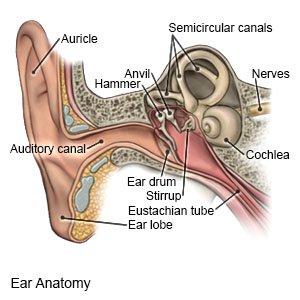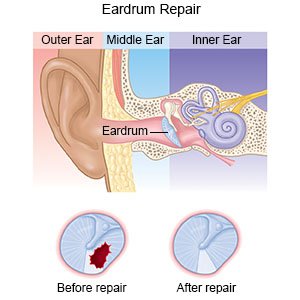Ruptured Eardrum
Medically reviewed by Drugs.com. Last updated on Aug 4, 2025.
What is a ruptured eardrum?
A ruptured eardrum is a tear or hole in your eardrum.
 |
What causes a ruptured eardrum?
- Air pressure changes from a plane ride or scuba diving
- Injury caused by objects put into your ear, such as cotton swabs
- Infections of your middle ear
- A head injury from contact sports, car accidents, and falls
- Ear surgeries or procedures
What are the signs and symptoms of a ruptured eardrum?
- Clear, thick, yellowish, or bloody ear discharge
- Hearing loss
- Ear pain
- Ringing or buzzing in your ear
- Dizziness
How is a ruptured eardrum diagnosed?
Your healthcare provider may use a tool called an otoscope to look inside your ear. An otoscope will allow your provider to see your eardrum and the size and location of the tear. Your provider will also be able to see any fluid or infection inside your ear.
How is a ruptured eardrum treated?
A mild rupture may heal on its own over time. Your healthcare provider may clean your ear and put a bandage over it. Your provider may also place a cotton ear plug in your ear to cover the tear.
- Antibiotic ear drops may be needed to treat or prevent an infection caused by bacteria.
- Surgery may be needed to repair your eardrum if the hole in your eardrum is large, or does not heal. You may need any of the following:
- Myringoplasty is surgery that uses a graft to cover your torn eardrum. A graft may be may be tissue taken from your own body or it may be artificial. A procedure called a mastoidectomy may also be done with a myringoplasty. A mastoidectomy is removal of infected bone from behind your ear.
- Tympanoplasty is surgery to repair your torn eardrum and any damage to your inner ear. The hole in your eardrum will be covered with a tissue graft. You may also need to have a mastoidectomy with your tympanoplasty surgery.

How can I care for my ruptured eardrum?
- Always keep your ear dry. Do not let your ear get wet, such as when bathing or swimming. Water may cause your damaged eardrum to heal more slowly and increase your risk for infection.
- Do not put anything in your ear. Never put objects such as cotton swabs in your ear. Pointed objects may damage or worsen the damage to your eardrum.
- Try not to blow your nose. The increase in pressure may cause further damage to your eardrum.
When should I seek immediate care?
- You are bleeding from your ear.
- You cannot move or feel areas of your face.
When should I call my doctor?
- You have a fever.
- Your hearing loss gets worse.
- You feel increased dizziness, or you are vomiting.
- You have worsening ear pain or a new buzzing sound in your ear.
- Your symptoms do not improve, even after you take your medicine.
- You have questions or concerns about your condition or care.
Care Agreement
You have the right to help plan your care. Learn about your health condition and how it may be treated. Discuss treatment options with your healthcare providers to decide what care you want to receive. You always have the right to refuse treatment. The above information is an educational aid only. It is not intended as medical advice for individual conditions or treatments. Talk to your doctor, nurse or pharmacist before following any medical regimen to see if it is safe and effective for you.© Copyright Merative 2025 Information is for End User's use only and may not be sold, redistributed or otherwise used for commercial purposes.
Further information
Always consult your healthcare provider to ensure the information displayed on this page applies to your personal circumstances.
